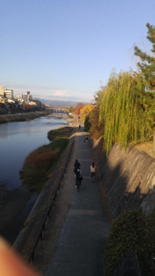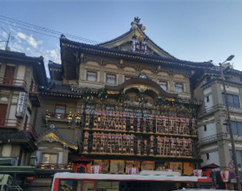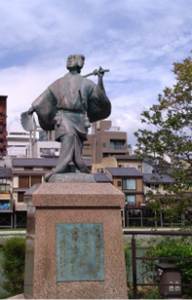Minamiza’s Invitation
Yoshie Doi
 Kamogawa on November 26, 2022 |

Front of Minamiza November 26, 2022 |
 Statue of Okuni northeast of Shijo Ohashi |
Okuni Kabuki and Minamiza
On November 25th, the signboard “Maneki” for the Kabuki performance “Kichirei Kaomise Show” was put up in front of the Minamiza Theater. Every year, it is a feature of December in Kyoto.
The roots of the kaomise performance go back about 400 years, to the kabuki dance performed by Okuni, who took the world by storm in 1603. After the Battle of Sekigahara, as society changed from turmoil to stability, the common people showed interest in the unknown world, and the Shijo-gawara River was a popular showhouse with peacocks and puppet shows.
And it seems that a group of mischievous people and Kabukimono, who survived the wartime period of Gekokujo, were roaming Shijo-gawara. The rogues were a group of unemployed samurai without a guarantor, a group of people who smoked cigarettes introduced from Nanban, and threatened the security of Rakuchu, such as tsujigiri.
On the other hand, Kabukimono comes from the word ‘kabuku’ and refers to a group of samurai who walked around in eccentric costumes that deviated from common sense. This “tilt” was a big fad in the early Edo period, and the roots of Kabuki are that Okuni, who was popular from the age of 11 with the Yayako Odori, imitated the costume of this kabuki performer. (see photo)
The bronze statue of Okuni, which stands northeast of Shijo Ohashi Bridge, is dressed in a costume recreated from the “Okuni Kabuki Zu Folding Screen” and is dressed in gold brocade and is dressed in luxurious men’s clothing. It seems that the townspeople of Kyoto were stunned.
Along with Kitano and Gojo-gawara, Shijo-gawara became a place for theater performances, and later, Kyoto Shoshidai Katsushige Itakura restricted theater and spectacle performances in Kyoto to Shijo-gawara, and prohibited other theater performances. The seven theaters were allowed to raise a yagura (turret), and the taiko drums played on top of the turret were a feature of Shijo Kawara in the Edo period, along with the turret.
One of the huts on the south side of Shijo is the roots of Minamiza, and the turret and two Brahma statues that still sit on the roof in front of Minamiza are remnants of the Edo period. The gables above the stage in the theater are proof that only the stage and box had a roof in the past. Few people notice the turret that still remains on the roof of Minamiza, but please check it out. It is said that gods descend on the turret.
In the early Edo period, the Kabuki stage followed the Noh stage, but the frontage of the stage became wider and wider. It was also around this time that the Kaomise, in which actors who had exclusive contracts with theaters gathered together, began.
By the way, at the “Kichirei Kaomise Performance”, “Maneki” is hung at the front entrance, and it is a large one made of a single cypress board with a height of 180 cm. Actor’s name is written.
This “maneki” is the etymology of the second man and the third man.The original meaning is that the name of the head of the family is listed on the first sheet, the leading actor is listed on the second sheet, and the next actor is listed on the third sheet.
The end of document
